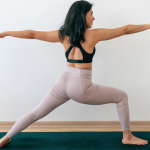The art of sequencing your yoga classes is to make them work for both your students and you, the teacher. As yoga teachers we give of ourselves, and often those that are drawn to teaching yoga are those who naturally want to share and help others. However, this can come at a cost to your own physical and emotional energy reserves. So, how can we sequence a week’s worth of classes while keeping it fresh for the students as well as making sure that we stay fresh as teachers?
Fresh Doesn’t Mean New
The key mistake that newly qualified teachers make is to think that every single class has to be unique, with all-singing, all-dancing variations that no one has ever tried before. They panic that if the students feel they’ve done this sequence before they’ll get bored and drift off to another class.
This simply isn’t the case. Sometimes in order for you to stay fresh, you need to go back to your archived lesson plans and use one you’ve done before. Even if it’s with the exact same class. The reason why this isn’t as much of a problem as you think is because, chances are, they won’t notice.
Even if they do, they will learn something from going through the same sequence again. Either they’ll have improved in some of the poses, or they’ll take something different from it. In fact, far from being a failure to keep everything constantly new, repetition is one of the core principles of yoga, for example the Ashtanga primary series.
Group Brainstorming
With any job, if you’re working flat out, you will get to the point of just running out of ideas. I feel this every time I have to think up what to give the kids for tea, and end up dishing up the same old tried and tested meals I’ve made a thousand times before.
In order to inject some momentum into your sequences, get in contact with some colleagues, perhaps some yoga teacher friends who graduated at the same time as you and who will understand your predicament, and suggest a group brainstorming session. Once you’re all putting ideas onto the table, you’ll be re-inspired with some exciting new lesson plan ideas, plus it’s a chance to share any ups and downs that you’ve experienced as a yoga teacher.
Get Anatomical
Good yoga teachers understand the inner workings of the body as well as any physiotherapist of sports massage therapist. In order to understand how to fully inhabit the yoga poses, the teacher must be clear about what muscles are working and how they are interconnected.
By working one particular group of muscles throughout the class the students should achieve a deeper level of stretch. So for example, if you’re aiming for handstand, choose poses that will work on opening up and strengthening the shoulders so that the students can achieve better flexibility of the shoulders.
Alternatively try having the spine as the focus of a week’s worth of lessons. Or focus on opening and strengthening the hips by including poses such as Adho Mukha Swastikasana, Bharadvajasana I, Utthita Marichyasana I and Supta Padangustasana I and II. By focussing on the anatomy of the body it gives the students a way into the poses, as well as giving you a clear focus for your sequencing.
See Also: Is Your Anatomy Holding Back Your Handstand?
Pick a Prop; Any Prop
This won’t work with all yoga styles, but if you teach in a studio that has props, then it can be a great way to sequence a class, or series of classes. Take, for example, the humble brick. Used imaginatively, the brick can become your student’s guru for the lesson.
So to begin the lesson, ask the students to place the brick in between their upper thighs while they stand in Tadasana. In order to keep the brick in place, they will need to grip in with their quadriceps and outer thigh muscles, teaching them the correct amount of work that needs to take place in the legs during the pose. They can then put the brick behind their back in Tadasana standing against the wall. They can hold the brick with their upper hand going into Trikonasana, then take their weighted top hand and arm back to encourage the rotation of the chest away from the floor. And so on.
Be in the Moment
As with the whole science and art of yoga, the key to keeping it fresh is by being in the moment. As a yoga teacher, the best way to stay in the moment is to actually look at what the students in front of you are doing. Over and over again my mentor told me that I need to look at what the students are doing, and only then will I be able to really teach them.
Whatever your sequences for the class happens to be, allow your students to guide the focus of your lesson. If a particular student struggles to find their balance in Virabhadrasana III, take the whole class to the wall and get them to do the pose with their fingertips to the wall. That way, the wobbling student gets to experience the pose, and the other students get to work on improving the alignment of their hips, spine and arms.
See Also: Woman vs Celery: How I Began Breaking My Mindless Habits
Don’t Forget to Rest!
However hardcore (or not) your classes may be, it’s still important to introduce recuperative asanas into your class to ensure that everyone has the energy to perform all the poses safely till the very end of the class.
It’s also a good chance for you to rest during the class. Insert poses such as Child’s Pose, Uttanasana, Prasarita Padottanasana, Upavista Konasana and Supta Baddha Konasana at regular intervals throughout the class and by the end of your class both you and your students should be in a calmer headspace.
Remember, that the most important part of your classes, is YOU. As long as you are enjoying what you’re doing, looking at your students and listening to your own body, you won’t be able to help keeping your classes fresh and exciting.













